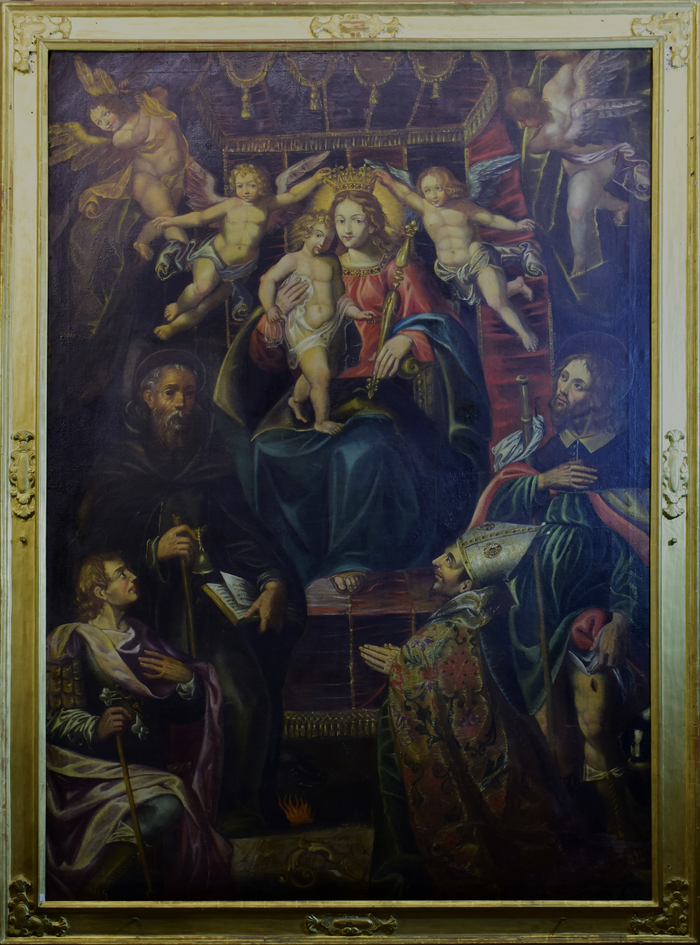Architettura e Paesaggio
Chiesa parrocchiale di Sant'Antonio Abate
- Saint Antonio Abate parish church [English version by Della Livorno, find out after the Italian text] (alternativo)
- Tipologia
- Tipologia edificio:
- edificio dedicato al culto religioso
- Notizie storiche
- Descrizione:
VAI ALLA MAPPA DEL VILLAGGIO OPERAIO - GO TO THE WORKER VILLAGE MAP
SCOPRI GLI ALTRI PANNELLI DEL PERCORSO - DISCOVER THE OTHER PANELS OF THE ROUTE
Dedicata a Sant'Antonio Abate, la chiesa di Miagliano fu eretta a parrocchiale (smembrandosi dalla parrocchia di Andorno) il 23 marzo 1779. Fu una delle prima nuove parrocchie nate dopo la costituzione della Diocesi di Biella (1772). Un primitivo oratorio, poi abbellito e ampliato, esisteva già alla metà del XV secolo, ai tempi della strega Giovanna. Le forme attuali sono state assunte con importanti e lunghi lavori durati dalla fine del Seicento alla prima metà dell'Ottocento. La dedicazione al grande santo eremita (morto ultracentenario nel 356) si spiega con la forte identità agricola della comunità miaglianesi. Sant'Antonio Abate, festeggiato il 17 gennaio, è celebre per essere invocato conto l'ergotismo, cioè il "fuoco" che porta il suo nome, ma soprattutto per il suo maiale, simbolo della vita semplice degli allevatori e dei contadini.
Tuttavia il Comune di Miagliano scelse laicamente un patrono diverso, Sant'Alessio. Leggendario mendicante della tarda latinità, Sant'Alessio è il difensore, ovvero il protettore per antonomasia. I miaglianesi lo preferirono al titolare della parrocchiale in occasione di un'epidemia dalla quale furono miracolosamente risparmiati, ragion per cui la devozione "istituzionale" si impose come alternativa a quella religiosa.
All'arrivo dei Poma, ossia dell'industrializzazione, la parrocchia di Miagliano e la sua chiesa erano già quelle che appaiono oggi.
Il ruolo del parroco (all'epoca dell'impianto della prima fabbrica era in carica don Pietro Varzo (o Valzo), di Montesinaro, cui nel 1889 fu la volta di don Luigi Bonesio di Andorno, poi tra il 1892 e il 1918 fu il tempo di don Pietro Zanello di Pontestura, cui subentrò don Bernardo Pivano di Biella, che tenne la parrocchia per trent'anni) fu di vitale importanza nel contesto di una comunità in così rapido cambiamento e incremento.
La realtà cattolica miaglianese fu attivissima e riuscì a contendere ai ben più agguerriti e radicati socialisti le preferenze degli operai del cotonificio, soprattutto all'approssimarsi della Grande Guerra e durante il conflitto. Furono figure come quella di don Giovanni Canova, viceparroco e "anima" dei cattolici di Miagliano d'inizio Novecento (fratello del celebre rabdomante don Rodrigo, maestro di scuola in quel di Tollegno), a schierarsi e a lottare contro la compagine socialista, inaugurando una stagione di impegno politico, sindacale e sociale in genere sempre più autorevole e capace di suscitare consenso.
Fu quello il periodo della costituzione della "Unione Miaglianese", della "Casa del Popolo" e della società sportiva "Labor et Fides".
- Descrizione:
- ENGLISH VERSION:
Saint Antonio Abate parish church
Miagliano’s church, that is dedicated to Saint Antonio Abate, was established as a parish (by detaching itself from the parish church in Andorno) on the 23rd of March 1779. It was one of the new parishes that were created following the formation of Biella’s Diocese (1772). In the half of the 15th century there already existed an early chapel which was later both improved and widened, during the times of the local witch, Giovanna. The present shapes were achieved through major and lengthy works which lasted from the end of the 16th century to the first half of the 18th century. The dedication of the church to the great hermit saint (who died super centenarian in 356 AD) can be explained with the strong farming identity of the Miagliano’s community. Saint Antonio Abate, whose celebrations fall on the 17th of January, is renowned for being called upon against ergotism, that is to say the “sensation of fire” that is associated with his name, but above all for his pig, which symbolizes a simple life led by both breeders and farmers.
However, the Town Hall in Miagliano made the secular decision of choosing a different patron, Saint Alessio was a legendary beggar in the late latinity and is the defender, in other words the protector for antonomasia. The inhabitants of Miagliano thought he would be preferable to the voted saint for the parish church on the occasion of an epidemic from which they were miraculously spared. For this reason the lay “devotion” imposed itself as an alternative to the religious one. Upon the arrival of the Pomas, or in other words of the industrialization, the parish church of Miagliano looked just as it does in the present day. The role of the parish priest became vitally important within such a rapidly expanding and growing community. (At the time when the first factory body was erected Don Pietro Varzo (or Valso) from Montesinaro was in charge; then in 1889 it was the turn of Don Luigi Bonesio from Andorno; then between 1892 and 1918 Don Pietro Zanello from Pontestura succeeded, followed by Don Bernardo Pivano from Biella, who owned the parish for thirty years).
The catholic practice in Miagliano was very active and was able to win over the mill workers’ preferences against the fiercest and most convicted of socialists especially nearing the outbreak of the First World War and during the conflict. It was such characters as Don Giovanni Canova, deputy parish priest and “the soul” of the catholics in Miagliano at the beginning of the 19th century (he was the brother of the celebrated diviner, Don Rodrigo, a school teacher in Tollegno) who stood up and fought against the socialists group, and in so doing he opened a season of political, trade union and social involvement that generally speaking gained increasing authority and was able to raise consensus.
That was the period when the “Unione Miaglianese” (Miagliano’s Alliance), the “Casa del Popolo” (the People’s Institution) and of the sports association “Labor et Fides” (work and faith).

